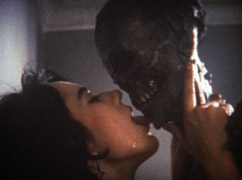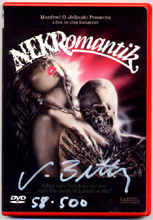![[Deep Focus]](../../../flicker/dvd/logo.gif) |
|
|
NEKROMANTIK |
|
Directed by Jörg Buttgereit Written by Buttgereit and Franz Rodenkirchen Cinematography by Uwe Bohrer Starring Daktari Lorenz and Beatrice M. Germany, 1987
|
 I've felt for a while now that I should post a disclaimer in front of my review of the two Nekromantik movies. It's not that I worry people are going to be offended by reading the review, but that the essay pre-dates the rest of the work on this Web site, and is written from a decidely different point of view. I've felt for a while now that I should post a disclaimer in front of my review of the two Nekromantik movies. It's not that I worry people are going to be offended by reading the review, but that the essay pre-dates the rest of the work on this Web site, and is written from a decidely different point of view.
Actually, it's a review that I yanked out of one of my old hand-written journals full of notes on various movies, street scenes, and other stuff that I used to scribble when I was in college, and during the months and years shortly afterward. Nekromantik had quite an impact on my young mind -- it came at a time when I was pretty seriously exploring horror film, and its feeling of intensity and conviction went way beyond most anything else I had seen up to that point. I posted it more or less unedited, though it was different in tone from most of my latter-day reviews, and even split it onto two pages, just so I could track whether or not people were interested in reading the whole thing after they had gotten halfway through my florid prose. To my great surprise, the majority of them were. I don't feel quite as strongly now as I did then about the potential for snotty underground filmmakers to help redefine the ways that we look at life and death. But I've just watched Nekromantik again for the first time in about seven years via the new DVD from Barrel Entertainment (fanboy that I am, I ordered the signed and numbered limited edition), and, while it's a frankly ridiculous film, I've gotta say I'm also surprised at how well it holds up. For the uninitiated, Nekromantik is one of the most notorious horror movies ever made. It may actually be reviled more than it is admired, even in horror circles, but it's one of those few movies that's provocative, in the truest sense of the word. Like David Lynch's Eraserhead, Tod Browning's Freaks, and Luis Bunuel and Salvador Dali's Un chien Andalou, it demands -- and gets -- a strong reaction. Nekromantik is the story of a nice young couple with unusual sexual proclivities. Specifically, in order to get off, they require congress with a human corpse -- or at least a nice selection of pickled organs. Fortunately for these two, the fella (Daktari Lorenz) has a good job on the clean-up crew that tidies up automobile accidents, and eventually winds up with a real find, a half-rotten carcass dragged out of a swamp. He brings it home, where he and Betty (Beatrice M.) give it a warm welcome in a distended love scene involving a striking optical-printing technique that leaves motion trails on the screen as someone (presumably Lorenz, who doubled as composer of the score) pounds out the lyrical love theme on a piano. It's not all hugs and corpses, however, and when Betty abandons Rob after a tiff, the corpse goes with her. At its heart, Nekromantik and its sequel constitute a sensitive (really!) parable of miserablism and impotence. OK, sensitive not so much in the actual filmmaking, which is obviously the work of a young punk with a healthy interest in both gore and filmmaking. What always got me is the actors -- after all, they have to sell this shit. It's rather unsettling to watch Daktari Lorenz take a pig's eyeball into his mouth (and even more cringe-making when you see the outtakes and realize he had to do that over and over again), and the vigor with which Beatrice M. (who would later appear in a bit part as a whore in Wings of Desire) gets naked and performs with the corpse is impressive. I found myself wondering what kind of evil genius convinced these two appealing performers that making this movie was a good idea. Further investigation reveals that Jörg Buttgereit, the man with the menacing name, isn't evil at all, but is a rather nice, self-effacing fellow who's made a career of traveling around the world with this movie. In the liner notes, Buttgereit maintains that he was always surprised at the "serious" reception for the film, which he claims is the work of "a naive bunch of loonies." But despite the fact that Nekromantik is cheap in appearance, it's pretty carefully produced. The camera moves, the shot compositions, and the long, wordless passages filled with inexplicable edits all contribute to the feeling that this is an art film in the garb of an exploitation film -- or vice versa. (Buttgereit even cites Godard's Pierrot le fou as inspiration for one sequence!) Demonstrating that you can't please everyone, not even gorehounds, some viewers complained that the gore was too far over the top while others said there wasn't nearly enough of it. This is a slow-moving tale, with weird digressions and surrealistic dream sequences that qualify as stream-of-consciousness filmmaking. Animal lovers won't appreciate the authentic footage of a rabbit being slaughtered, but it's woven into the story as a clue to Rob's history. (In an apparently uncharacteristic move, Buttgereit actually explains himself on the DVD's commentary track.) Granted, it's amateurish on the whole, and a few sequences fall completely flat. But the film is surprisingly easy to watch, assuming you appreciate its deadpan sense of humor and identify on some level with its simultaneously grim and prurient preoccupation with body parts both actual and simulated. Part of the fun is figuring out when Buttgereit's kidding and when he isn't. The whole corpse-fucking fetish can be seen as a fairly obvious satire of the interests and lifestyle of death-obsessed goth types, for instance. (I still giggle at the scene where Rob learns that Betty has left him, and stares dejectedly at the stain on the wall where their corpse used to hang.) Then again, the subtext is made pretty clear -- Nekromantik is about people who've been traumatized by encounters with death, and are working out a resultant obsession by indulging an unusual sexual fetish. For horror, I think that's good enough -- profound, even. And despite Buttgereit's protestations to the contrary, his little sex/horror film is sincere in its heart. Anyone who chooses to make horror movies is working out his own relationship with the depths of the human psyche, mapping out that territory. And if the film gently mocks the meek, hand-wringing Rob and the disarmingly pretty Betty with her dark, tousled hair, it's a self-mocking gesture on the part of a filmmaker who's indulging his own fascinations.
The disc includes an amusing audio commentary from Buttgereit and co-writer Franc Rodenkirchen, as well as an edited version of the Corpse-Fucking Art documentary, which dealt with the making of the film and its sequel. Also featured is early Buttgereit short "Horror Heaven," a Karloff-dedicated homage-cum-satire of genre standbys (The Mummy, Frankenstein, etc.); it's marginally more interesting than the "Hot Love" short that was included on the CFA videotape -- but that's not saying too much. Oh yeah ... my original review resides here.
| |

| |
 Cultists will appreciate the new DVD from a company I had never heard of before -- Barrel Entertainment, out of Shelby Township, Michigan. As far as I can tell, this is Barrel's one and only DVD release, and it's the first exposure many viewers will have to the film, which was briefly available on videotape from Film Threat in the early 1990s and never had a theatrical distributor (its U.S. theatrical premiere didn't take place until 1995). The movie will never look better, but don't expect a sharp picture -- this was originally shot in Super 8, and the DVD transfer was made from the producer's 16mm blow-up internegative. It's a dramatic improvement over the tape, however. The only way the disc could be much better is if Nekromantik 2 -- slower, but with a nifty climax -- were included as a hidden supplement.
Cultists will appreciate the new DVD from a company I had never heard of before -- Barrel Entertainment, out of Shelby Township, Michigan. As far as I can tell, this is Barrel's one and only DVD release, and it's the first exposure many viewers will have to the film, which was briefly available on videotape from Film Threat in the early 1990s and never had a theatrical distributor (its U.S. theatrical premiere didn't take place until 1995). The movie will never look better, but don't expect a sharp picture -- this was originally shot in Super 8, and the DVD transfer was made from the producer's 16mm blow-up internegative. It's a dramatic improvement over the tape, however. The only way the disc could be much better is if Nekromantik 2 -- slower, but with a nifty climax -- were included as a hidden supplement.
 http://www.deep-focus.com/flicker/
bryant@deep-focus.com
http://www.deep-focus.com/flicker/
bryant@deep-focus.com